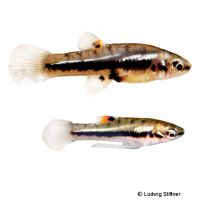Least Killifish (Heterandria formosa)
| Least Killifish Heterandria formosa | |
|---|---|
| Name | Least Killifish |
| Name Lat. | Heterandria formosa |
| Family | Livebearers |
| Family lat. | Poeciliidae |
| Order | Killifishes & Livebearers |
| Order lat. | Cyprinodontiformes |
| Origin | North America |
| Habitat | Streams, ponds |
| Diet | Omnivore |
| pH | 7.0-8.0 |
| Behavior | ♂ territorial |
| Keeping | Group |
| Care Level | Easy |
| Reproduction | Livebearer |
| Breeding | Simple |
| Life Span | 2-3 years |
| Protection | No |
| Metric Units | |
| Size | 2-4 cm |
| Temperature | 20-26 °C |
| Hardness | 10-20 °dH |
| Aquarium | ~ 50 l |
| US Units | |
| Size | 0.8"-1.6" |
| Temperature | 68-79 °F |
| Hardness | 178-356 ppm |
| Aquarium | ~ 10 gal |
Distribution and habitat
The range of the dwarf carp is the southeastern United States, from North Carolina to southern Louisiana. They live in weedy, sluggish flowing and stagnant waters with dense riparian vegetation. Occasionally they are found in brackish water.
Maintenance
The aquarium should have a varied, partly dense planting, with shelters and hiding places (e.g. perforated rocks, roots) and provide sufficient swimming space. A dark substrate and shaded light (floating plants) is ideal.
No ammonia, ammonium and nitrite should be detectable, the nitrate value should not exceed 100 mg/l. To ensure the water quality and oxygen content, a filter and heater adapted to the aquarium size is required, as well as lighting for the species-appropriate day-night rhythm of the animals.
Diet
In nature they feed on insects, small crustaceans, plankton and algae. The food supply consists of small live foods, such as cyclops, daphnia and artemia, which are also accepted without problems in frozen form, supplemented with frozen special food mixtures. In addition, they regularly require vegetable food, such as algae leaves, pureed leafy and wild vegetables or dry food (flakes, granules, micro-pellets) with high vegetable content (spirulina, kelp)
A regular and varied diet promotes health and increases resistance. Only feed as much as is eaten immediately (in a maximum of 10 minutes).
Behaviour and compatibility
Due to their small size they are not suitable for a community tank. However, they can be socialized with other very small and peaceful fish. Harmless fights may occur among the males in competition for females. At least 5 dwarf carps should be kept together, with females predominating.
Basically, only compatible fish species with similar demands on water condition and water temperature may be socialized.
Sex dimorphism
Males are smaller and have an anal fin (gonopodium) that has been transformed into a mating organ. The females are larger and appear rounder.
Reproduction and breeding
They are live-bearing fish. Internal fertilization is provided by the male's gonopodium. The gestation period is about 4 weeks. Unlike all other viviparous toothcarps, the eggs do not develop at the same time, but one after the other (superfetation). Every 1-4 days, 1-6 relatively large fry are born. After filling their swim bladder at the water surface, they can immediately begin feeding. The parents hardly chase the young fish
Fry must be fed several times a day with special rearing food (dust food, Artemia nauplii). In community tanks breeding is hardly possible, because the fry are easy prey.
Important
In winter, the water temperature can be lowered to 16-18 °C.
Soft water is not well tolerated and makes them susceptible to disease. The addition of sea salt (mineral salt) from the pet store to harden the water prevents.
The well-being of the fish should be monitored regularly. Temperature should be checked daily, pH, hardness and nitrate levels should be checked at least every 14 days. Regular partial water changes are recommended, even if the contaminant level has not yet reached the upper limit. Sudden changes in water quality should be avoided. Newly introduced fish must be accustomed slowly to the water in the aquarium.
Further literature can be found in your pet store.
References
Text: Werner Winter; Image: Ludwig Stiftner
Source: BMELV (1998): Tierschutzgutachten - Haltung von Zierfischen (Süßwasser); RIEHL & BAENSCH (2006): Aquarien Atlas Bd. 1, Mergus Verlag; ENGELMANN (2005): Zootierhaltung - Tiere in menschlicher Obhut: Fische, Verlag Harri Deutsch
- Gemäß § 21 Abs. 5 Tierschutzgesetz idgF
